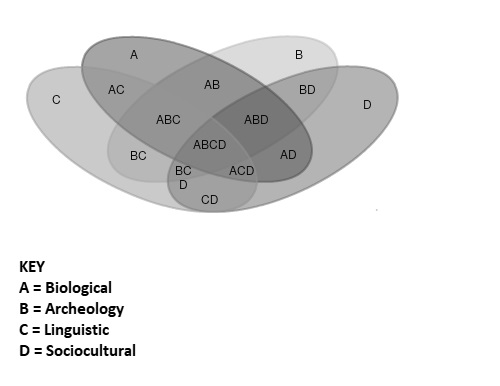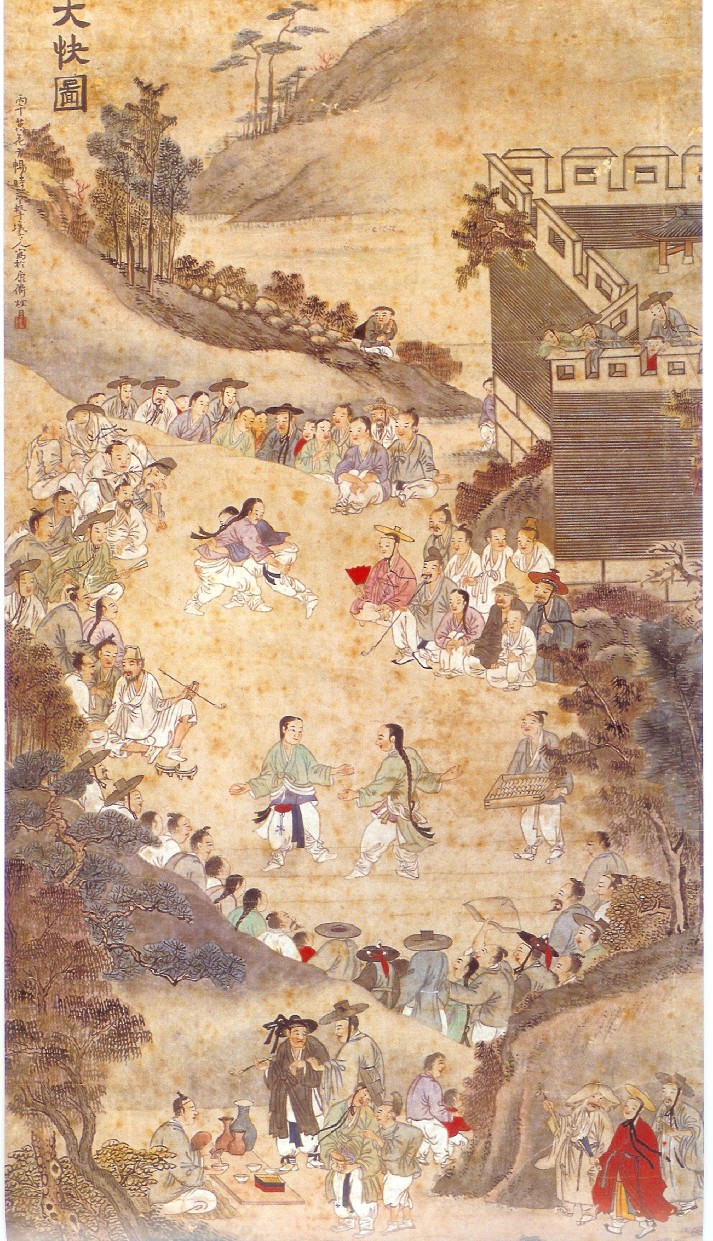Article begins
Is a four-field approach to specific anthropological research questions feasible in the modern era or is the idea dead? The authors suggest a new approach that makes four-field investigations practical and fruitful.
There are numerous roadblocks to four-field studies within American anthropology, some active, some passive. The dearth of anthropologists trained in the four fields is due, in large part, to contemporary anthropologists not believing that it can be done (or is worth the effort). Our work shows that it can be done in the context of the study of human movement systems, and the resulting research benefits from this holistic agenda. Four-field approaches to anthropology serve to break out of a strictly sociocultural mode of investigation, even though sociocultural questions may lie at the heart of the inquiry. As such, this kind of analysis could be a model for more general investigations in anthropology, and may provide an avenue to contesting the fragmentation in the discipline that has existed for over a century. Indeed, it could be the crucible for a new kind of anthropologist.
Consider the following Venn diagram:

Image description: A grey scale Venn diagram depicting four overlapping oval fields. Each quadrant is labeled with a different combination of A (Biological), B (Archaeology), C (Linguistic) and D (Sociocultural).
Caption: Intersections of the four fields. John Forrest
The diagram graphically displays possibilities for dialog within the four fields, the possible combinations of the fields, and also allows for the subdisciplines to be pursued independently of one another. Venn diagrams are a tool of set theory. The individual members of each set make up the total set, but some of the members reside in more than one set. So, for example, the study of vocal production involves both biological anthropology and linguistic anthropology. Set theory calls the place where members reside in two (or more) sets, the intersection, and designates it with the symbol ∩ (usually pronounced as “cap”). Thus, vocal production would be in A∩C.
Reviewing current and previous research in anthropology, you will find that some of the locations on the diagram, e.g., A∩B and C∩D, are well represented by recent research, and others, e.g., A∩B∩C and A∩D, are more sparsely populated. Yet, pick any research topic that fits under the general umbrella of the American Anthropological Association and you can fit it somewhere on this diagram. We argue that A∩B∩C∩D is a viable option for some research topics. This option is typically not pursued for a number of reasons, yet could be a significant departure for the field were it given more attention.
In our individual researches on systems of bodily movement, holistic, four-field strategies were both obvious and necessary tools for completing our studies.
Both of us began our research projects by being interested in the general question of why contemporary practitioners of certain martial arts and dances accept, unquestioningly, narratives about the histories of their respective movement practices that are not supported by empirical evidence. We wanted to know why these practitioners are adamantly resistant to documented history when it is presented to them, preferring to cling to their origin tales. These questions led us to take a four-field approach because our research would have been shallow or inconclusive without these multiple lines of attack. Many of the practitioners of certain martial arts and dances are attracted to them initially precisely because of the origin tales, which are strongly nativistic, and these practitioners continue to cleave vociferously to these origin tales in the face of substantial contrary evidence. We are interested in why such narratives are so strongly appealing. To be as proficient as possible in our inquiries it was absolutely necessary to employ methodologies from all four fields. Hence, our work fits in the intersection A∩B∩C∩D. We will summarize one segment of our work here.
Based on his training in the martial arts, Forrest-Blincoe initially intended to discover what ethnic or national symbols were used in martial arts training that set Korean martial arts apart from other East Asian styles. In that respect, his research started as a strictly cultural anthropology project, supplemented with insights from anatomy and biological anthropology. What quickly became apparent however, was that neither the physical movements themselves, nor the other cultural symbols used in training, could definitively explain what made these styles a unique product of Korean cultural history. Many of the techniques in Korean martial arts are shared with Japanese and Chinese styles, so that they could not be used alone to answer the research question sufficiently. Likewise, the philosophical elements of the martial arts which made connections to religion and etiquette are also common to all three East Asian cultures. One clue was that many teachers and practitioners asserted that each style of Korean martial arts continued “traditional” Korean fighting practices in their long unbroken history.

Image description: An image of two (mostly naked) men facing each other engaged in Subak. One is poised to strike the other with an open-handed slap. The other is in a defensive position.
Caption: Frontal slap in Korean Subak. CC BY-SA 4.0
Forrest-Blincoe examined historical sources and archaeological sites to determine if the assertions about the “traditional” nature of Korean martial arts were empirically supported. From a historical perspective, was possible to claim that current martial arts were developed from older Korean martial arts? Also, if there was a historical basis for the claims of certain martial arts being “traditional” practices, was there an identifiable Korean way of fighting, distinct from Japanese and Chinese styles?
The historical evidence presented an incomplete and contradictory picture of Korean martial arts before the middle of the twentieth century. The official history of Taekwondo, for example, states that the martial art was developed in part from Japanese Karatedo and in part from Taekkyon, another Korean style. Taekkyon, in turn, is said to have evolved directly from Subak, the oldest type of fighting referenced by any Korean author. However, a review of the history of pedagogy and techniques in Taekwondo revealed that it was initially virtually identical to Japanese Karatedo, and did not show any clear links to Taekkyon. Even the naming convention for the style (specifically the addition of the suffix -do) reflected post-war Japanese practices rather than Korean practices. Furthermore, though the styles of Taekkyon, and Subak are named in primary sources prior to the twentieth century, they are neither described nor depicted in any great detail, so the body of techniques in these styles is either incomplete, or missing entirely. This fact further contradicted the claims of an unbroken history of Korean martial arts and also made it impossible to identify any way of fighting that might be uniquely Korean.

Image description: A complex painting showing two distinct martial arts bouts (each between two men) and a surrounding crowd of people watching them.
Caption: The “Dae kwae do” (1846) by Hyesan Yu Suk showing Ssireum (above) and Taekkyon (below). Public domain
There were no indications of physical techniques in fighting practices in the Korean historical record, but the language of the primary sources helped to clarify some of the questions still left unanswered. Although the first reference to Subak by a Korean author does not contain descriptions of physical techniques, descriptions of the Chinese practice, Shoubo, written with the same characters as Subak (手搏) do give some indication of how the martial art was performed. Linguistic comparison between classical Chinese and Korean sources revealed that Subak and Shoubo were likely to be similar if not the same practice, although they also cast doubt on the claims of an unbroken tradition of Korean fighting practices. Whereas modern Korean sources refer to Subak as if it were the name of a classical style of martial arts, comparison with historical Chinese sources show that Subak was more likely a class of fighting practices rather than an individual style. The historical data also verified the claim that Taekkyon was the oldest surviving style of martial arts on the Korean peninsula. In contrast to Subak, or other historical martial arts such as Kwonbop, which were written using Chinese characters, the first reference to Taekkyon is written in the native Korean alphabet, Hangul, reserved for native Korean words or concepts.
There are numerous roadblocks to four-field studies within American anthropology, some active, some passive.
With this cultural, linguistic, physical, and archaeological or historical information at his disposal, Forrest-Blincoe returned to his original research question with new insight into the development of Korean practices, and could reassess their modification in the twentieth century and why origin narratives that were not supported by empirical evidence were so prevalent. Many Korean martial arts such as Taekwondo were founded soon after World War II, during which time Korean nationalists used native Korean historical concepts and the Korean language as symbols of purely Korean practices. In martial arts, this was done to disguise the foreign roots of particular styles and to help give legitimacy to a new country by claiming its history and cultural practices were on equal terms with those of China and Japan. These nationalistic origin stories are propagated today to reinforce the legitimacy of the country in part due to the continuing tensions between North and South Korea, but also due to South Korea’s relatively precarious economy. Furthermore, as styles like Taekwondo, a practice that may have originally been indistinguishable from Japanese styles, but which developed through international competitions, became uniquely Korean, there was a need for a native Korean origin story.
Franz Boas did not see the utility of four-field analysis beyond his desire to separate out the concept of culture from nineteenth-century paradigms of general evolution. With that aim achieved he was content to let the discipline segment. Consequently, he missed an immense opportunity to broaden anthropological theory. In our individual researches on systems of bodily movement, holistic, four-field strategies were both obvious and necessary tools for completing our studies. Dancers and martial artists use their physical bodies, they use specialized language to talk about their activities, they incorporate history into their training, and their styles all have deep sociocultural meanings. If we use slightly different terminology for the four fields: anatomy, history, language, and culture, the great expansion of the number of areas of research that could use a four-field approach becomes even more apparent. The obstacle at present is the lack of training avenues for PhD candidates, which arises in part from a lack of interest in four-field studies by institutions and in part from a lack of resources. That situation could change should the utility and practicality of four-field studies be better understood.
John (Juan) Forrest is professor emeritus of anthropology at Purchase College, SUNY. He specializes in dance and aesthetics and has undertaken major fieldwork projects in North Carolina, New Mexico, Argentina, and Cambodia. He is the author of the forthcoming book, Doing Field Projects: Methods and Practice for Social and Anthropological Research (Wiley-Blackwell).
Badger Forrest-Blincoe is a new doctoral student at SUNY Binghamton. He is a fourth dan master in Tang Soo Do, a Korean form of karate, and has trained in both the United States and Korea. He has also done fieldwork on a range of martial arts in East and Southeast Asia for the past five years.
Cite as: Forrest, John and Badger Forrest-Blincoe. 2020. “New Approaches to Four-Field Anthropology.” Anthropology News website, November 24, 2020. DOI: 10.14506/AN.1546

